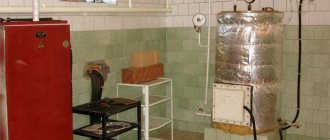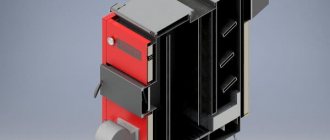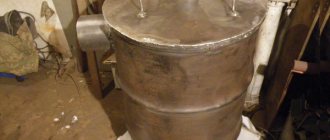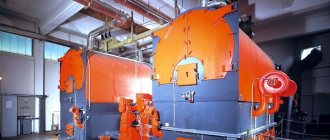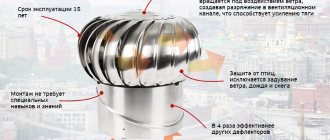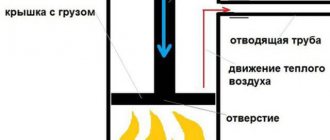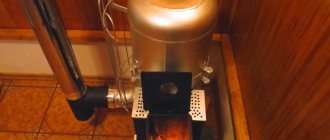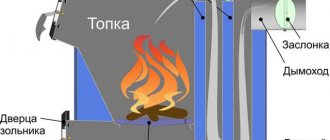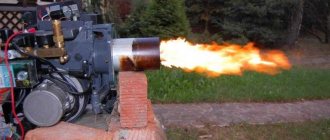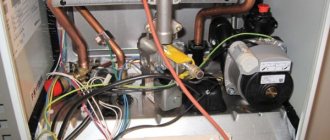Installation device
Reviews of a pyrolysis boiler usually describe the general impression of the device and do not talk at all about its structure. But for those who want to make such a device themselves, this information will be very useful:
1. Loading compartment.
It is into this compartment that fresh air without impurities of low temperature (referred to as “primary”) enters. This is where the stored fuel is burned.
2. Compartment intended for final combustion.
Air at elevated temperatures with impurities enters this compartment (called “secondary”). Directly in this place, all small particles that were not burned in the first compartment are burned. The second compartment is separated from the first by means of a grate (fuel material is placed on it).
3. Heat exchanger compartment.
Here, the air or liquid inside the heat exchanger is heated with heat from the burnt fuel. From this compartment, the high-temperature coolant is distributed throughout the rest of the system and returns here with an already reduced temperature.
4. Exhaust fan for air supply.
For smaller devices, either natural draft is used (which is ineffective) or a fan. For larger and more powerful devices, you should use a smoke exhauster, which will create forced draft inside the device.
5. Adjustment devices for adjusting the power of the device.
DIY pyrolysis boiler: drawings (video)
A pyrolysis boiler has many advantages. This is a reliable system that allows you to get the maximum amount of heat from wood combustion. You can purchase a factory version or make a boiler yourself at home.
- Author: admin
Rate this article:
- 5
- 4
- 3
- 2
- 1
(1 vote, average: 5 out of 5)
Share with your friends!
Advantages and disadvantages of the device found in reviews of the pyrolysis boiler
Let’s take a closer look at the positive reviews about the pyrolysis boiler, namely what advantages they claim:
1. The average burning time of the material from one load of fuel (about 12 hours). Achieved by adjusting the supply of “primary” air. For comparison, heating with wood of such boilers: wood-burning - 3.5 hours, top burning - 30 hours.
2. Complete burnout of the laid material. There is no need to frequently clean the unit from ash.
3. Less air in the apparatus increases the time spent burning the material. The process becomes more economical.
4. Adjustment devices help make the operation of the unit more automated, which greatly facilitates its use.
5. Higher environmental friendliness of the device compared to conventional wood-burning options. The use of already polluted air (“secondary”) reduces the amount of harmful emissions into the atmosphere, since some of them are finally burned inside it.
6. It is possible to use material for burning large sizes (there is no need for careful and exhausting chopping of firewood).
Among the disadvantages, owners of such devices highlight the following:
1. The main disadvantage is the price. Purchasing such a device will cost almost twice as much as a conventional wood-burning model.
2. They need to be connected to the network to ensure the operation of the smoke exhauster.
3. The moisture level of the material being laid for combustion is important (not higher than 20%).
4. If the device is not fully loaded, combustion failures and tar formation are observed.
In general, the purchase of such a device can quickly pay for itself, and with proper use it will help you save a lot of money later. It is quite difficult to make such a device yourself without special skills and a very high-quality and detailed diagram.
Principle of operation
The operation of this heating equipment is based on the principle of pyrolysis (thermal decomposition) of solid fuel.
During the combustion of fuel, subject to limited air access, combustible components are formed that have a high calorific value. These are methane, methanol, hydrogen, ethylene, carbon monoxide, pyrolysis resin. The process of decomposition of solid fuel occurs in the temperature range of 200-350C. Volatile pyrolysis products are transported to the afterburner chamber, in which, with a sufficient amount of oxygen, they are completely burned, releasing a significant amount of heat. Heat is transferred to the coolant through heat exchange surfaces.
A boiler room based on thermal power plants does not need smoke exhausters, since the draft provided by a properly constructed chimney is sufficient to remove combustion products.
Popov's pyrolysis boiler with mechanical adjustment of the coolant does not depend on the power supply. It can maintain the required temperature within half a degree. Fuel is added to the installation once or twice a day, which is determined by the volume of the loading chamber.
Ash can be removed from the unit even during operation, and it does not need to be completely removed. Around large oxidizer pipes, ash is specially left in a layer 5-50 mm thick, which serves as a catalyst for thermochemical processes.
The operation of the Popov heating installation can be stopped at any time using the control system.
Advantages
It is not by chance that Popov’s long-burning boiler gained wide popularity. Great user demand is due to a number of advantages that this unit has:
- the boiler can operate for a long time on one stack of firewood;
- since no toxins are formed during the combustion of fuel, the operation of the boiler is environmentally friendly;
- owner reviews indicate that with proper care, the Popov pyrolysis boiler can last for many years;
- The solid fuel unit is easy to maintain and operate;
- characterized by high thermal efficiency;
- the device can operate on any type of solid fuel (even wet);
- The accumulation of ash is small.
You can read about the Kholmov long-burning mine boiler here.
Do-it-yourself Popov boiler assembly guide
Pressed sawdust
Assembling the boiler with your own hands is carried out in several simple steps. However, first you need to thoroughly understand the operation of the equipment, then it will be much easier to assemble it.
The raw materials are placed in the oven in several layers, each of which is carefully compacted. The more densely you compact the raw materials, the higher the efficiency of the unit will be. Even an ordinary stove will heat much more efficiently if it is loaded with carefully dried firewood, let alone Popov’s pyrolysis boiler.
The simplest version of such a boiler is in many ways similar to an ordinary potbelly stove. However, the homemade unit in question, unlike a potbelly stove, can work on one load of fuel for half a day, or even a whole day! The duration of operation depends on the volume of the loading chamber and the characteristics of the fuel used. If desired, such a boiler can be used not only for heating the house, but also for smoking various meat products.
Popov boiler assembly kit
- Fuel reservoir.
- Steel sheets. You will need sheets with a thickness of 2-3 mm and 4-5 mm.
- Welding machine.
- Bulgarian.
- Rectangular pipes 6x4 cm.
- Round pipes with a diameter of 4 and 5 cm.
- Cement mortar.
- Bricks.
First stage
Make 2 cylinders from sheet steel. One cylinder should have a slightly larger diameter than the other. You will insert the smaller cylinder into the larger one and attach a lid on top. You can also make it yourself from sheet steel. Weld the bottom. The lid and bottom should have a thickness 2 times greater than that of the tank walls. Make the cylinders from steel 2-3 mm thick, and use 4-5 mm steel to make the lid and bottom.
Second phase
Prepare the pipes. The products should be of such a size that they can be inserted into each other normally - this will make it easier for you to assemble the Popov boiler. Rectangular pipes are installed vertically, round pipes are welded to the boiler horizontally.
A total of two pipes will be connected to the boiler. Heated water will be discharged through one, and cold liquid will be supplied through the second. To install pipes, first prepare holes with a diameter of 0.5 cm in the walls of the boiler.
Fourth stage
Check the boiler body for leaks
It is important that the installation does not allow smoke and water to pass through. The check is extremely simple - just pour water into the pipes and monitor the condition of the system
If leaks are found, seal the holes by welding.
Fifth stage
Install the assembled structure into the frame. The frame is made of brick. For masonry, use cement mortar. If possible, it is recommended to make this frame in advance, but this is not critical.
Loading fuel into the Popov boiler
Thus, there is nothing complicated about self-assembling the Popov boiler. Complete the described tasks sequentially, and you will have at your disposal an efficient, productive, reliable and cost-effective heating unit that is in no way inferior to expensive factory-produced analogues.
Good luck!
Design of the Popov pyrolysis boiler
Popov’s heating unit consists of two chambers: the lower one – the pyrolysis chamber and the upper one – the afterburning chamber for pyrolysis gases.
The afterburning chamber consists of two sections separated by a horizontal partition. The unit is equipped with three regulators:
- Small oxidizer pipes located under the door regulate the power of the heating installation by changing the oxygen supply to the pyrolysis chamber.
- The upper gate, located on the upper pipe of the heat generator, is designed to regulate the operating characteristics of the unit by changing the rate of removal of flue gases.
- There is a damper located in the center at the front of the installation, which prevents flue gases from entering the room.
Above the combustion chamber there is a secondary air supply unit for afterburning pyrolysis gases. The block contains swirlers that evenly distribute heated air throughout the entire volume of the chamber.
As the flue gases move towards the outlet, they undergo intensive heat exchange with the coolant, which makes it possible to reduce the temperature of the combustion products to 140C.
The draft required for the operation of the TEU is provided by a chimney, the length of which is at least 7 m. At the same time, the horizontal section should not exceed one meter. The top point of the chimney should be at least 300 mm above the roof canopy, which will prevent flue gases from being blown into the room. The smoke exhaust pipe throughout the area in contact with the external environment must be insulated. To clean the chimney, a hole with a door is provided at the bottom.
If a water storage tank is connected to the system, then it is advisable to install a three-way valve. This will allow the coolant to move in a small circle through the storage tank, which increases the temperature of the coolant at the inlet of the return pipe into the unit. Increasing the temperature of the coolant in the return pipe allows you to extend the service life of the heating installation.
All types of solid organic fuel, the humidity of which does not exceed 65%, including all types of coal and peat, can be used as an energy carrier for this heating equipment. Modifications with gas burners are also available, allowing operation with mains or liquefied gas.
Reviews about the Popov boiler are very diverse - both positive and negative. Therefore, before purchasing such equipment or making it yourself according to drawings, it is advisable to consult the users of this unit. Representatives of the official manufacturer of the Popov Boilers TEU, NPP Ultrazvuk LLC, claim that counterfeits may appear on the heating equipment market that are not capable of providing the declared characteristics.
Difficulties of self-production
The high cost of heating equipment is one of the negative factors. You can try to make a long-burning Popov boiler with your own hands - the drawings and assembly procedure are partially available on the Internet. In practice, this is problematic - there are no exact diagrams with the dimensions of equipment components. All that is known is the grade and thickness of the steel used.
During the design and manufacturing process, you may encounter the following problems:
- Due to the high temperature of the pyrolysis gases, the walls of the afterburning chamber are made of 10 mm thick refractory steel. It is difficult to weld such a structure at home while ensuring tightness.
- Dimensions of the channel for exhaust gases relative to the volume of the fuel block. They directly affect power, but only the equipment designer knows the correct ratio.
- Serpentine heat exchanger. Its manufacture requires bending steel pipes, which can lead to thinning of the walls. With prolonged exposure to temperature, this will cause depressurization.
Boiler design features
1 - exhaust pipe damper (external damper)2 - cover of large oxidizer pipes3 - small oxidizer pipes4 - combustion chamber door5 - internal damper6 - injector hole7 - inspection cover8 - condensate drain pipe9 - supply and return pipes10 - water drain pipe11 - safety group pipe boiler12 - exhaust pipe flange
The unit itself is assembled from 2 main chambers. The pyrolysis process takes place in the lower chamber, and the resulting pyrolysis gases are burned in the compartment installed at the top. The upper section is further divided into 2 sections using a horizontal partition.
The boiler is equipped with three regulators, namely:
- small pipes. These elements are installed below the boiler door. These oxidizer pipes are needed to change the power of the heating unit by changing the volume of supplied air;
- top gate. This element is located on the upper heat generator pipe. Allows you to adjust the main characteristics of the boiler by changing the smoke removal rate;
- central gate. Installed on the front of the unit. Thanks to this device, smoke will be prevented in the boiler room.
A block is installed above the fuel combustion compartment, through which secondary air enters the chamber, which is necessary for afterburning the pyrolysis gases. The design of this unit includes swirlers, which ensure the most uniform distribution of heated air throughout the chamber space.
Flue gases move in the direction of exit from the chamber. At this stage, a very intensive transfer of their heat occurs in favor of the coolant used. As a result, combustion products cool down to approximately 140 degrees.
Popov's boiler
The recommended length of the smoke exhaust pipe of the Popov boiler is 700 cm. When using a shorter pipe, a deterioration in draft will be observed. Try to keep the length of the horizontal section of the chimney no more than 100 cm. The “street” part of the pipe must be insulated. Make a hole with a door at the bottom of the chimney. Through it you can conveniently clean the structure as it becomes clogged.
If desired, you can connect a water storage tank to the boiler. In this case, it is recommended to install a three-way valve. Thanks to it, the coolant will be able to pass in a smaller circle through the tank, due to which the temperature of the water at the return inlet to the unit will increase. This will help increase the service life of the Popov boiler.
Modifications of boilers equipped with gas burners are available for sale, through which you can set up the operation of the unit using liquefied or main gas. However, it is better to avoid self-assembly of a gas modification of the boiler, because This is a very responsible job that requires high qualifications. The slightest mistakes can lead to life-threatening situations.
Operating principle of the device
To understand how true the reviews about the pyrolysis boiler are, you need to find out on what principle the device generally works:
1. At the first stage, fuel is loaded into the required compartment, the door to it is tightly closed, and the forced draft device is turned on.
2. Since there is not enough oxygen in this compartment and the temperature is maintained very high, the fuel begins to slowly char instead of burning quickly. As a result, the same pyrolysis (wood gas) begins to be released from the material.
3. Next, the products released during charring are lowered under the grate on which the fuel is stored (grid).
4. At this point, already heated air (called “secondary”) is mixed with them, which burns small volatile particles.
5. The heat generated during this process rises to the fuel and maintains the temperature required to char it.
Operating principle, setup details
Unlike standard solid fuel models, you need to know how to properly heat a Popov boiler. It is recommended to use bulk fuel - sawdust, wood shavings. Their mass creates the required pressure on the pyrolysis zone; the density does not allow the gas to rise upward.
- Loading fuel, checking the top cover for leaks.
- Ignition of logs, the lower damper is open as much as possible.
- After the flame is formed, the access of air into the fuel chamber is limited.
- During the combustion of pyrolysis gases, the temperature of the water in the heat exchanger is controlled.
At the first stage, it is important to ensure good traction. The upper gate must be fully open. After 20-30 minutes of operation it can be partially closed. If combustion products enter the boiler room, the gate is opened again.
Device and types
A device such as a pyrolysis boiler is a rather complex mechanism, practically a home laboratory. It produces wood gas, which is directly used to heat the room. And this happens due to the decomposition of organic compounds when exposed to high temperatures, as well as under the condition of limited oxygen flow.
This device is a unit equipped with two cameras. The loading chamber, which is located at the top, operates at a temperature of 200-800 degrees; it is at these temperatures that exothermic pyrolysis reactions begin. Under such conditions, firewood begins to decompose into two fractions: charcoal and pyrolysis gas, which in turn consists of CO with small impurities of CO2.
Then the resulting gas-air mixture enters the afterburning chamber located below, the combustion temperature in this chamber reaches 1100-1200 degrees. Accordingly, a large amount of heat is released, which is intended for heating the room.
After the chambers there is a smoke path, it is in it that the received heat is transferred to the heating system, and soot accumulation occurs in this path. Thus, it turns out that to produce heat, the boiler burns not wood, but the resulting gas, with an efficiency of about 86-91%.
These types of boilers are equipped with a draft switch; it is needed to ignite the device. First, when the device starts up, it burns for some time, like a direct combustion boiler. And when the valve is closed, it begins to work in pyrolysis mode. So let’s look at what is the difference between the types of these devices.
Popov oven: principle of operation and obvious advantages
An alternative to similar devices is the Popov solid fuel boiler, based on the use of the pyrolysis effect. What does this mean? The design of the combustion chamber of this device is made practically airtight, i.e., the access of oxygen into it is strictly limited. It is no secret that oxygen is necessary for a complete combustion process, otherwise it simply will not occur.
Based on this factor, a minimum air input into the combustion chamber is still provided. However, its amount is so insignificant that full combustion does not occur. Instead, a procedure of slow smoldering of solid fuel occurs. In this case, heat transfer is significantly lower than with full combustion of materials. But thanks to its design, this difference is almost imperceptible.
The Popov stove contains one secret inherent in its design. It involves the re-combustion of exhaust gases. What does this mean? During the slow decay of wood, which is the main fuel element used in this stove, a significant amount of smoke is released, which also contains a certain amount of unspent fuel. It is this that is redirected to the next compartment, where it is recycled.
As a result of this process, it is partially burned and the heat transfer of the entire device increases. The remaining twice-processed fuel is discharged out through the chimney. Ultimately, the Popov furnace produces excellent performance with relatively low consumption of solid fuel. All these factors make it possible to highlight and structure the advantages of this device over other similar devices. They look like this and best characterize the qualities of this stove:
The above qualities have made the Popov stove one of the most functional solid fuel devices existing today. Its heat transfer characteristics and relatively low wood consumption suggest the optimal qualities of this device.
